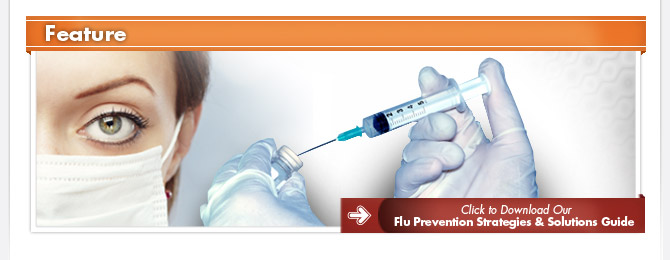 |
 |
| ||||||
|
| It's Time to Fight the Flu It's October 1, which means flu season is officially underway. According to the CDC, it will most likely spike in January or February before coming to a close in May, but being prepared now can help you lessen the flu’s effects on your facility. The CDC recommends taking the following steps to help prevent flu and other respiratory infections from spreading throughout your facility1: 1. Promote and administer the seasonal flu vaccine. The CDC recommends the flu vaccine as the best defense against the seasonal flu. The vaccine is approved for everyone six months of age and older. The vaccine will be available as intramuscular, intradermal and nasal spray formulations. 2. Take steps to minimize potential exposure. Respiratory hygiene, cough etiquette and proper hand hygiene should be observed by residents, staff and visitors. (One way to encourage respiratory hygiene is to download the CDC’s "Cover Your Cough" poster here.) 3. Monitor and manage ill staff members. Staff members who develop a fever and respiratory symptoms should not come to work. If the symptoms develop at work, they should stop all resident-care activities, don a facemask and notify their supervisor of their illness before leaving work. 4. Adhere to standard precautions. Standard precautions assume that every person is potentially infected or colonized with a pathogen that could spread throughout the facility. The elements of standard precautions that pertain to individuals with respiratory infections are performing hand hygiene and wearing gloves and gowns. 5. Adhere to droplet precautions. Droplet precautions should be implemented for residents with suspected or confirmed influenza for seven days after illness onset or until 24 hours after the resolution of fever and respiratory symptoms, whichever is longer. 6. Use caution when performing aerosol-generating procedures. Some procedures are more likely to generate higher concentrations of infectious respiratory aerosols than coughing, sneezing, talking or breathing. Examples include bronchoscopy, sputum induction, elective intubation and extubation, CPR and open suctioning of airways. These procedures should only be performed on residents with suspected or confirmed influenza if they are medically necessary and cannot be postponed. 7. Manage visitor access and movement within the facility. If a resident is in isolation for a confirmed case of influenza, their visitors should be limited to people who are necessary for their emotional well-being and care. 8. Monitor influenza activity. The facility should have a plan for alerting staff about increased influenza activity within the facility. Staff should also be aware of when collection of clinical specimens for viral culture could help public health efforts. Close communication and collaboration with local health authorities is recommended. 9. Implement environmental infection control. Standard cleaning and disinfection procedures are adequate for influenza virus environmental control within a healthcare facility, including patient areas in which aerosol-generating procedures are performed. 10. Implement engineering controls. Consider installing engineering controls that reduce or eliminate exposure by shielding staff and residents from infected individuals. Examples include partitions and curtains. 11. Train and educate healthcare personnel. Ensure that all healthcare providers receive job- or task-specific education and training on the prevention of influenza during orientation and on an ongoing basis. 12. Administer antiviral treatment and chemoprophylaxis when appropriate. Refer to the CDC's website for the most up-to-date information and guidance. 13. Identify personnel at higher risk for influenza complications. Staff members who are pregnant, have given birth within the last two weeks, are 65 or older or have chronic diseases such as asthma, heart disease, diabetes, immunity-suppressing diseases, some chronic conditions and morbid obesity are at higher risk of flu complications. Professional Medical has everything you need to develop a comprehensive flu prevention and management strategy for your facility! To learn more, contact your ProMed territory manager, visit us online at promedsupply.com or give us a call at 800.648.5190. Reference 1 Centers for Disease Control and Prevention. Prevention Strategies for Seasonal Influenza in Healthcare Settings. Available at: http://www.cdc.gov/flu/professionals/infectioncontrol/healthcaresettings.htm. Accessed Septmeber 11, 2013. | |||
 |
 |  |
| Product pricing is only visible to registered promedsupply.com customers. If you are not yet registered, give us a call at (800) 648-5190 and our Customer Care Professionals will be happy to get you set up. | |||
 |
 |
 |